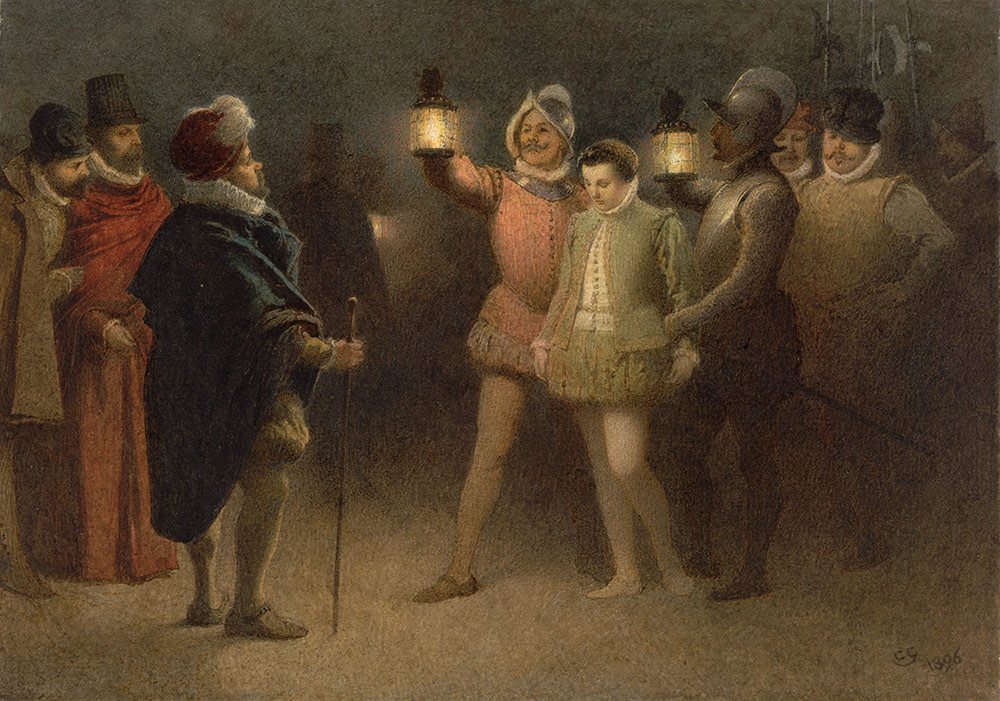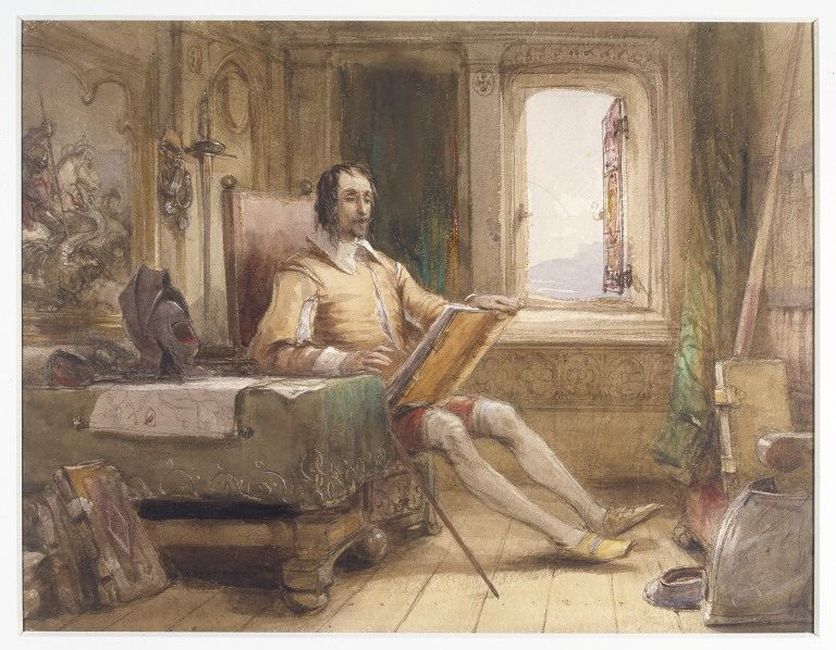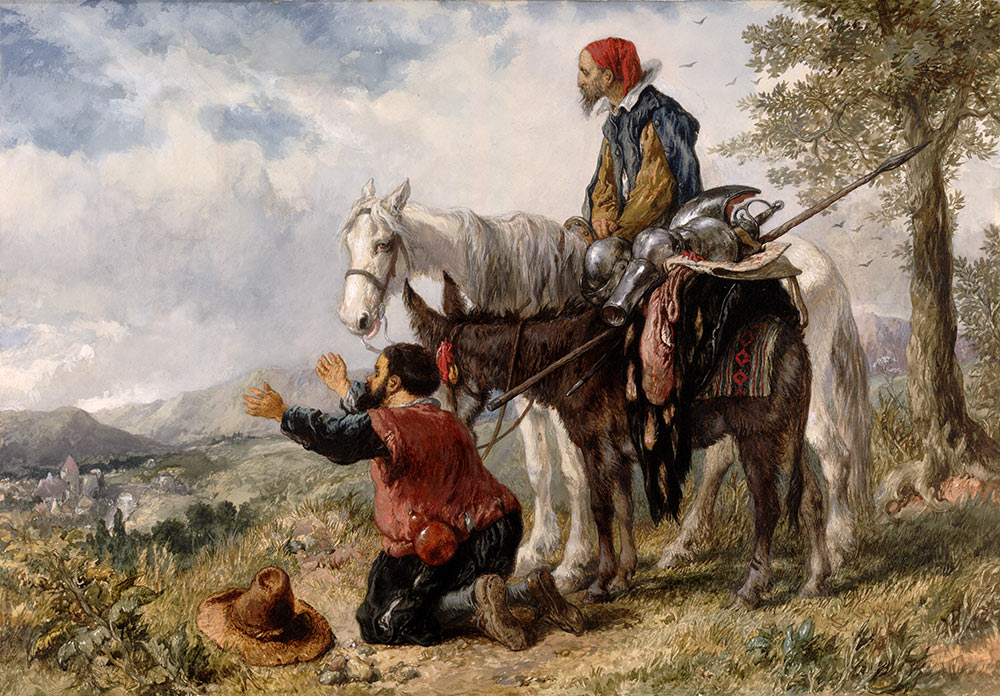ENGLISH PAINTERS
British Watercolours 1750-1900: Historical & Literary Genre
'Don Quixote and Sancho Panza returning to their Village', by Sir John Gilbert, 1866, watercolour. Museum no. 1762-1900, © Victoria and Albert Museum, London
The 19th century saw a flowering of interest in history, encouraged by the publication in 1814 of the first of many historical novels by Sir Walter Scott. These fictions were woven around such notable characters as Queen Elizabeth I, and set in carefully researched historical locations. The past became the playground of artists, and Charles Cattermole's picture of 'Charles I and his secretary' is typical of such imaginative recreations of British history.
The imagination and invention of artists was also endlessly fed by British writers. Eve of St Agnes by Sir John Everett Millais, is taken from Keats' evocative poem of the same name. It is a beautiful example of a work inspired by literature rather than being straight-forwardly illustrative. The works of Charles Dickens were particularly popular subjects of Victorian literary painting. Cattermole's The Grave of Little Nell' exemplifies the Victorian sentimental fascination with the tragedy of Little Nell told in 'The Old Curiosity Shop'.
Perhaps surprisingly Miguel de Cervantes' novel Don Quixote was also popular with Victorian audiences. Written between 1605-15, it was the story of an adventurous Spanish knight and his squire. Charles Green started painting illustrations for publishers. But 'Sancho Panza, Governor of Barataria, going the Round with the Night Watch', shows us the amazingly delicate technique which won him his reputation as an independent watercolour artist.
In contrast, the focus of Sir John Gilbert's 'Don Quixote and Sancho Panza returning to their Village' is the authentic representation of costume and accessories. Early in his career Gilbert filled sketch books with studies of the Royal Horse Artillery and the hallmark of his work was an eye for the detail of uniform, armour, military equipment and horses. Such watercolours assumed a literate audience and were encouraged by the popularity of the new 'Annuals' (illustrated magazines). It was said of Gilbert that, 'a narrative read, he at once knows how best a picture can be made. His fertility of pictorial invention is inexhaustible'.
The 19th century saw a flowering of interest in history, encouraged by the publication in 1814 of the first of many historical novels by Sir Walter Scott. These fictions were woven around such notable characters as Queen Elizabeth I, and set in carefully researched historical locations. The past became the playground of artists, and Charles Cattermole's picture of 'Charles I and his secretary' is typical of such imaginative recreations of British history.
The imagination and invention of artists was also endlessly fed by British writers. Eve of St Agnes by Sir John Everett Millais, is taken from Keats' evocative poem of the same name. It is a beautiful example of a work inspired by literature rather than being straight-forwardly illustrative. The works of Charles Dickens were particularly popular subjects of Victorian literary painting. Cattermole's The Grave of Little Nell' exemplifies the Victorian sentimental fascination with the tragedy of Little Nell told in 'The Old Curiosity Shop'.
Perhaps surprisingly Miguel de Cervantes' novel Don Quixote was also popular with Victorian audiences. Written between 1605-15, it was the story of an adventurous Spanish knight and his squire. Charles Green started painting illustrations for publishers. But 'Sancho Panza, Governor of Barataria, going the Round with the Night Watch', shows us the amazingly delicate technique which won him his reputation as an independent watercolour artist.
In contrast, the focus of Sir John Gilbert's 'Don Quixote and Sancho Panza returning to their Village' is the authentic representation of costume and accessories. Early in his career Gilbert filled sketch books with studies of the Royal Horse Artillery and the hallmark of his work was an eye for the detail of uniform, armour, military equipment and horses. Such watercolours assumed a literate audience and were encouraged by the popularity of the new 'Annuals' (illustrated magazines). It was said of Gilbert that, 'a narrative read, he at once knows how best a picture can be made. His fertility of pictorial invention is inexhaustible'.

'Sancho Panza, Governor of Barataria, going the round with the night watch'
Charles Green
1896
Watercolour
Museum no. 1776-1900
© Victoria and Albert Museum, London
Charles Green
1896
Watercolour
Museum no. 1776-1900
© Victoria and Albert Museum, London

Don Quixote in his Study
Watercolour, circa 1840
George Cattermole, born 1800 - died 1868
Bibliographic References Victoria and Albert Museum Charles Dickens: An exhibition to celebrate the centenary of his death London: HMSO, 1970. P.3. Catalogue of the exhibition held at the Victoria and Albert Museum, June-September 1970.
The full text of the entry is as follows:
Of Don Quixote Dickens wrote 'I was never in Don Quixote's study, where he read his books of chivalry until he rose and hacked at imaginary giants and then refreshed himself with great draughts of water, yet you couldn't move a book in it without my knowledge or with my consent. ('Nurse's Stories, The Uncommercial Traveller')
As soon as the first new numbers of the Pickwick Papers had been published a comparison was drawn between Mr Pickwick and Sam Weller on the one hand, and Don Quixote and Sancho Panza on the other."
Watercolour, circa 1840
George Cattermole, born 1800 - died 1868
Bibliographic References Victoria and Albert Museum Charles Dickens: An exhibition to celebrate the centenary of his death London: HMSO, 1970. P.3. Catalogue of the exhibition held at the Victoria and Albert Museum, June-September 1970.
The full text of the entry is as follows:
Of Don Quixote Dickens wrote 'I was never in Don Quixote's study, where he read his books of chivalry until he rose and hacked at imaginary giants and then refreshed himself with great draughts of water, yet you couldn't move a book in it without my knowledge or with my consent. ('Nurse's Stories, The Uncommercial Traveller')
As soon as the first new numbers of the Pickwick Papers had been published a comparison was drawn between Mr Pickwick and Sam Weller on the one hand, and Don Quixote and Sancho Panza on the other."

